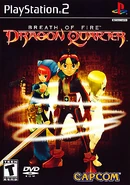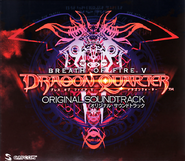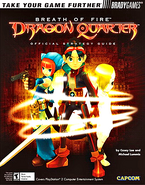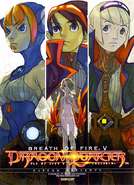Breath of Fire: Dragon Quarter (known as Breath of Fire V: Dragon Quarter in Japan) is the fifth main game in the Breath of Fire series. It was released in 2003 for the PlayStation 2. Illustrations were done by Tatsuya Yoshikawa.

Breath of Fire - Dragon Quarter Opening
Intro
Gameplay
Breath of Fire: Dragon Quarter offers a a major departure from previous installments of the series. The game is a full 3D title with cel-shaded character models. There is no world map; instead, the world consists of full 3D environments that are connected together and divided by sectors. There are no resting spots such as inns to recover the party's health; thus, the players have to rely on consumables.
The game introduces several new concepts such as the PETS system, SOL System, and D-Counter.
Positive encounter and tactics system (PETS)
Dragon Quarter incorporates a combination of real-time strategy and turn-based combat in what is called the Positive Encounter and Tactics System (PETS). There are no random encounters, instead enemies can be seen on the field and combat is engaged when either the player strikes the enemy with their weapon or the enemy touches the player's character.
The real-time strategy portion, or "Positive Encounter", the player and enemies can move about in the environment together at the same time. During this time, the player can set up traps to hurt the enemy or lures to occupy the enemy. If either the player attacks an enemy or the enemy touches the player, the actual combat initiates. The actual combat portion, or "Tactics", is a turn based battling system based on tactical RPGs such as Final Fantasy Tactics. Any traps and lures not used up will still be effective. If the player attacks the enemy and the characters can easily overpower the enemy, the enemy is instantly defeated and the player is awarded Party XP equal to the amount of regular experience points earned.
Experience
Party XP is bonus XP that is stored and can be used on the characters out of battle as regular experience points. Party XP is usually awarded after battles. During battles, the player is rated based mostly on the tactical advantages the player has before the battle (such as attacking first or using traps) and how fast the player defeats the enemy and is expressed as a percentage as high as 300%. This is multiplied by the regular experience points awarded to determine how much Party XP is earned.
Scenario Overlay system
One of these features is the Scenario Overlay (SOL) system. This system encourages the player to return to previous points in the game, restart the game, and/or replay the game in order to unlock hidden areas, view additional story scenes, and make the characters more powerful so that the player can deal with the game's considerable difficulty level. Unlocked scenes from this system will have the letters "SOL" on the bottom right to indicate that the event is a SOL unlocked event.
Because of how this system works and the game's difficulty, it is implied that the player is encouraged to not finish the game on the very first run and, instead, continuously restart. As enemies become stronger at a faster rate than the player characters, returning to earlier points of the game is a necessity to complete the game. The player is literally expected to lose difficult encounters and retry with additional capabilities. When the player loses, obtains 100% on the D-Counter, or uses an option called "Give Up" (to be used only when the game is deemed impossible to continue), the player is given two options -- SOL Restore and SOL Restart. SOL Restore allows the player to restart at the last save point with the characters at the same level in which they were defeated, while SOL Restart restarts the game entirely. Either option allows the player to retain any equipment equipped, any skills obtained, any Party XP earned, and any items and Zenny in storage.
The SOL system would be later re-used for Capcom's Xbox 360 game Dead Rising since both games share some development team members.
D-Counter
The Breath of Fire series took a leap and restricted Ryu to one dragon form, and he is limited in its use through the "Dragon Counter", a timer of sorts that slowly goes up to 100%. It has been calculated that you gain .01% for every 20 steps (though late in the game it may decrease to 9 steps), .01% per turn in battle, 1.0% for D-Diving (transforming into the dragon form), 1.0% for using the weakest attack (10AP), 1.25% for the medium attack (20AP), and 1.5% for the strong attack (30AP), as well as 1.0% per turn in battle for staying as a dragon. Ryu also has access to a D-Breath attack which rapidly fills the D-Counter while also rapidly increasing the damage done to the foe. Given enough time and sacrificed D-Counter, even the most powerful boss can be killed in one blow.
If the D-Counter reaches 100% before a certain event in the game, the dragon within Ryu takes over his body and soul and the game is over. The dragon form itself is extremely powerful, easily capable of defeating most boss characters with frightening speed. It is therefore a challenge among players to have the lowest Dragon Counter rating by winning the game as quickly as possible without using the Dragon abilities (if the player chooses "End" after reaching 100% on the D-Counter, a disturbing cutscene shows Odjn erupting from Ryu's body).
D-Ratio
Finally, there is an element of replayability in the form of the D-ratio, which is a rank that in the story is determined at birth, but in the game one can increase his or her D-ratio from the base of 1/8192 to as high as 1/4 (the dragon quarter), which makes certain areas of the game accessible. The highest "lock" in the game is 1/256, while the Dragon Blade you find in replays (which is based on your D-Ratio) maxes out at 1/8, so getting 1/4 is simply for show. In the game itself, D-ratio is a measure of the chance a person has to "link" with a dragon; the higher, the better. Therefore, people with higher D-ratios are wealthier and more powerful than those with lower D-ratios. In addition, the low-Ds are forced to live on the lower, more polluted regions of the world. In any event, the story doesn't change even when your D-Ratio changes (the game's characters will still refer to you as a Low-D, even when you have D-Ratio 1/4).
The D-Ratio for the replay mode is calculated at the end of the game by determining the player's rating. Some factors that determine this rating are time to complete the game, percentage of battles that were initiated by the player, number of treasure chests open, and percentage of maps explored.
Finite Resources
Due to the finite resources, players are encouraged to be very careful during enemy encounters and using consumables. Enemies do not respawn, so it is impossible to grind for XP or farm for zenny/items during a playthrough. Permanent saves require the use of Save Token, which are found in specific locations or dropped from certain foes.
Characters
Party Members
- Ryu - The main character of Dragon Quarter, he has been given the ability to transform into a dragon for a limited period of time. He travels along with Lin, Nina and Bosch.
- Nina - She is a victim of an experiment that surgically grafted Air Filters into her back. To keep the the experiment secret, she also had her vocal chords removed which made her mute.
- Lin - An agent of Trinity, a group that is opposed to the current government. Because of this, her D-Ratio number has been erased. She meets Ryu shortly after he rescues Nina, and joins him in protecting her as they climb to the surface.
- Bosch - At first, he is Ryu's partner and "friend" in the Rangers, but later becomes one of the principal antagonists throughout the game. He comes from a rich family (he is the son of Vexacion, one of the Regents) and has been raised to fight in a manner similar to ancient Spartans (a particularly disturbing SOL sequence shows a prepubescent Bosch killing a Genic five times his size, at the demand of his father). This means he possesses a great deal of both political and physical power. He fights Ryu a total of three times in the game, each time growing more and more obsessed with defeating his former partner. He has a D-Ratio of 1/64.
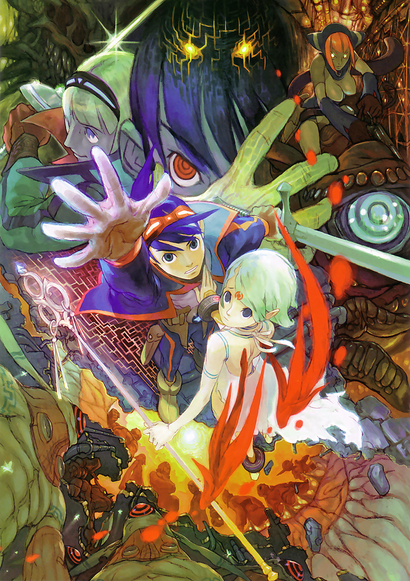
Promotional art.
Regents
Regents are high ranking officials who act like a board of directors to govern the underground world. All of them possess high D-Ratios.
- Deamoned - is the former leader and oldest of the Regents. He met his match when he lost an eye and was defeated by Elyon. When he learns of Ryu's powers, he leaves the other Regents to deal with him by himself. He is very skilled in hand to hand combat.
- Cupid - is the youngest of the Regents. He's very skilled with magic and can sense a "good" or "bad" aura amongst people, and beyond this "aura," he can glimpse the future. He can also summon an invincible monster to his aid. Cupid is male in the Japanese version, but female in the US version.
- Hortensia - is a sorceress who is said to be able to manipulate time and space as she pleases. She speaks of a prophecy that "Man will grow wings and reach for the sky". She specializes in mind game-like tactics.
- Jezuit - is a smooth talking Regent who specializes in swift hand to hand combat. Since he has the lowest D-Ratio among the Regents, he is opposed to the idea that D-Ratios should be used to determine everything. He likes to flirt with Hortensia and doesn't seem to take anything seriously. His specialty is transforming into an invisible wolf-like monster.
- Vexacion - is Bosch's father and a master of sword fighting skills called "Beast Skills". He is one of the longest serving Regents, rivaling Deamond and Elyon. He has the twins Ryked and Nalaka as his apprentices. He is known as Kensei (or "sword saint"). His specialty is using powerful attacks such as Kirin Flight and Twin Wake.
- Elyon - is the leader of the Regents. He was the first to be Chosen by Odjn and, as such, has the nickname "Origin". He gave up on opening the gate because he was too worried that he wasn't doing it of his own free will, and that he might be risking the lives of all the people in Shelter. Afterwards, he broke the link with Odjn, and decided to become a Regent and wait for the next Chosen. Since he gave up, his link to the dragon was severed. By the time Ryu appears, he has watched numerous Chosen link to dragons but fail to reach the surface. He's dying, worried what will happen to the world if he dies, yet he gives Ryu one last chance, even though Ryu isn't a Chosen. Elyon was responsible for Odjn linking to Ryu, and it was his command that Nina be surgically altered (probably to help fulfill Hortensia's prophecy).
Plot
An unspecified amount of time before the game begins, humanity has fled the desolate surface world to the underground in order to survive. Now, the world lies in a state of turmoil; polluted and stagnant, only the upper classes are able to escape to higher levels with better air. The game follows Ryu, a low level citizen, who rebels against his government in order to save the life of Nina, who is unable to survive underground, due to experimental surgery performed on her in order to convert her into an air purification machine. According to Breath of Fire tradition, dragons play a large role in Dragon Quarter, and Ryu himself is able to transform into a dragon. Despite this tradition, however, the main influence of Dragons is felt in the storyline of the game and not the gameplay - unlike every other installment, Ryu can only transform into one Dragon form. The focus of the story is on Ryu's escape to the surface with Nina, accompanied by the ever-watchful Lin.
There are two main subplots in the game; the first one concerns the five mysterious rulers of the entire underground world, who seem to be ubiquitous in their ability to gain information and their ability to act on it. These rulers also reveal the storyline via a legend passed down that says a boy with the power to become a dragon will bring the world back to the surface.
The other subplot is introduced almost at the outset of the game: the rivalry between Ryu and Bosch, the latter of which is portrayed as an entitled, monomaniacal elitist. Early on in the story, Bosch inadvertently releases Ryu's ability to become a dragon when he tries to kill him; after he has seen this power, Bosch's will to beat Ryu in battle drives him to undergo experimental dragon fusion, eventually resulting in his ability to become a dragon as well.
Development
Breath of Fire V was first announced by Capcom in 2002. The project was helmed by longtime series director Makoto Ikehara, who was inspired to create a game with a dystopian setting after reading the alternate history novel "Gofungo no Sekai" (五分後の世界, lit. The World Five Minutes From Now) written by Ryu Murakami. Character designs were done by series veteran Tatsuya Yoshikawa and utilized a thin and angular design for the characters. Music was handled by Hitoshi Sakimoto who is best known for working on SquareEnix's Final Fantasy Tactics game, and Yasunori Mitsuda who is best known for his soundtrack to Chrono Trigger.
The game was designed to be difficult because the director felt the previous installments were "too easy" and as development on, the game grew gradually more difficult. The game incorporated many of the design trends that RPGs were experimenting with in the early 2000s, such as the removal of a world map in favor of a real time environments, and the removal of random encounters. The game also tackled the issue plaguing the genre such as easy difficulty and lack of replay value. The game heavily utilizes Russian words and thought to help reinforce the dystopian feel. The game also played with many longtime series staples such as Ryu no longer being mute, and the removal of many of the clans, and the return of the Ranger organization.
The game suffers from a rushed development which resulted in several story and gameplay mechanics being dropped. An online mode was removed fairly early on in development and the fishing mini-game was dropped later as the deadline drew near. The director wanted to place a scene in the game that showed how the surface was destroyed but it had to be cut due to deadline restrictions.
After the game's Japanese release, Capcom announced it would be coming to the U.S. and PAL regions. In an odd twist of events, the number V was dropped from the title instead of the game's subtitle, making it the only entry to retain its subtitle outside of Japan.








